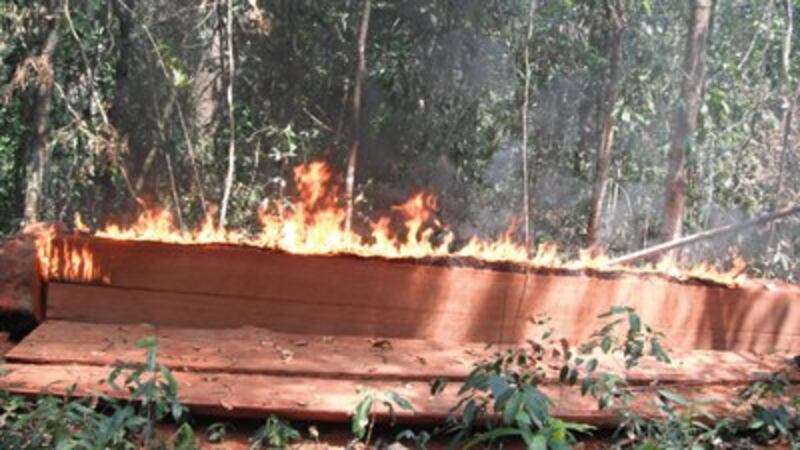More than 200 Cambodian villagers fashioning themselves after characters from the “Avatar” environmentally themed animation film clashed Wednesday with police and security guards at a sawmill which they said has been logging illegally and depriving them of forest resources.
The activists gathered at the Seng Saravuth Sawmill, demanding to see for themselves whether the company had been stocking illegal wood gathered from the Prey Lang forests in Kampong Thom province’s Sadan district in central Cambodia.
They also wanted to determine whether the sawmill's management had been granted a license to operate, and under what conditions, by the local government.
The shouting villagers, who had gathered from communities throughout Kampong Thom, Kratie, Preah Vihear, and Stung Treng provinces, soon attempted to force their way into the sawmill, leading to a standoff with authorities.
After a U.N. Human Rights official intervened, the villagers succeeded in entering the sawmill, at which point District Governor Sim Vanna read them a directive from the Ministry of Agriculture granting the sawmill license to process local wood into furniture until May this year.
Green groups said the sawmill may have been used as a front for exporting illegally logged wood.
Chhut Vuthy, president of Cambodia’s Natural Resources Conservation Group, which led the five-day campaign, said the activists’ inspection had proven that the sawmill does not comply with the government directive read to the villagers.
“The sawmill doesn’t process the wood. Instead it is a place where the sawmill owner keeps wood cut from Prey Lang forest that is waiting to be shipped out,” he said.
“The sawmill doesn’t even have processing equipment, but there are trucks to transport the stored wood and fresh wood cut from the forest.”
A protesting villager said that the group had no choice but to raid the sawmill in order to protect the forest.
“If the company cuts down the forest, what will the villagers rely on? In this area we don’t have enough land to cultivate, so it is important for us to be able to [among other things] take resin from the trees,” he said.
He called on the company to discuss the impact of deforestation with the villagers.
“Just because the government grants you a license doesn’t mean you can do anything you want without discussing it with the villagers,” he said.
A female villager, meanwhile, shouted her concerns about how the forest is necessary to supporting the group’s livelihood.
The sawmill protest marked the culmination of a five-day journey on foot through the forest by the communities who rely on the Prey Lang forests for their livelihood aimed at eradicating illegal logging in the area.
During the walk, villagers burned at least 400 cubic meters (14,125 cubic feet) of illegally cut wood abandoned in the forest. They also set ablaze 10 small sawmills and confiscated at least 130 logs of high-quality timber.

Rights groups critical
Rights groups offered their support for the “Avatar” activists, saying the local government should work harder to ensure that companies were not exploiting the forests under its watch.
And Cambodian rights group Adhoc official Chan Soveth, who monitored the campaign, said that while villagers had achieved their goal of gathering and raiding the sawmill, they had not succeeded in getting the government to act.
“The villagers have failed to prevent forestry crime because the provincial authorities didn’t take any measures to combat those crimes,” he said.
The Prey Lang activists have been championing conservation by wearing dress and makeup inspired by the blockbuster movie "Avatar," which depicts the destruction of a forest on an alien world and its inhabitants' bloody fight to protect their home from miners.
Most of the wood from Prey Lang is smuggled into China and Vietnam, where it is made into furniture and exported worldwide, some environmental groups have charged.
Some 90 percent of Cambodians live in rural areas and depend strongly on the country’s water, land, and forest resources, and critics have slammed the government for failing to preserve adequate land for its people, despite granting thousands of hectares in land concessions to private companies.
In 2008, Global Witness found that Cambodian forest coverage had dropped to 35 percent from 59 percent in 1997. Forests covered 73 percent of the nation in 1969.
Reported by Uon Chhin for RFA’s Khmer service. Translated by Samean Yun. Written in English by Joshua Lipes.
